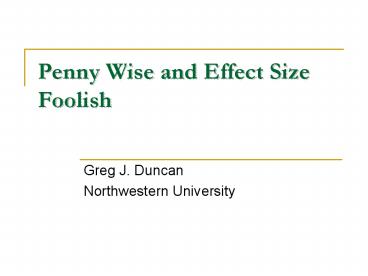Penny Wise and Effect Size Foolish - PowerPoint PPT Presentation
1 / 27
Title:
Penny Wise and Effect Size Foolish
Description:
Tricks of the trade. Consider total rather than just taxpayer costs and benefits ... Tricks of the trade - II. Measure outcomes that can be linked to important ... – PowerPoint PPT presentation
Number of Views:111
Avg rating:3.0/5.0
Title: Penny Wise and Effect Size Foolish
1
Penny Wise and Effect Size Foolish
- Greg J. Duncan
- Northwestern University
2
Penny Wise and Effect Size Foolish Greg Duncan
and Katherine Magnuson Child Development
Perspectives, forthcoming
3
Consider the Tennessee Star class size experiment
- Assigned children to classes that averaged 15 vs.
22 students for a mean of 2.3 years - Schanzenbach (forthcoming) estimated a .15
standard deviation achievement impact on ACT test
scores at the end of high school. - According to Cohen, .15 is a decidedly small
effect size - Are small classes bad policy?
4
Costs and benefits of Tennessee Star
- The smaller class translated into additional per
pupil expenditures of 11,500 - The economics literature suggests that a one
standard deviation increase in test scores
produces a 20 percent increase in lifetime
earnings - .15 standard deviation achievement impacts
translate into lifetime earnings gains of
17,000, some 1.5 times the interventions cost - Other possible benefits (e.g., crime reduction)
might add to benefit total
5
In general, there is no in general
- Inexpensive programs with small effects may
generate more benefits than costs and thus be
worthwhile public investments - Expensive programs with big effects may cost more
than they are worth
6
Tricks of the trade
- Consider total rather than just taxpayer costs
and benefits - Total social cost and benefits participant
taxpayer costs and benefits - Consider a wide array of potential benefits
- measure more than intended program targets
- E.g., an early behavioral intervention might
reduce grade failure or placement in special
education, and boost test scores
7
Tricks of the trade - II
- Measure outcomes that can be linked to important
social costs - E.g., grade failure, reduced crime, higher
productivity (earnings) - Try to measure spillover benefits and costs
- E.g., Does improving one childs behavior enable
classmates to learn more? - Do immunizations prevent epidemics?
8
Tricks of the trade - III
- Measure outcomes that cannot be monetized
- E.g., tolerance, citizenship
- After monetary benefits and costs have been
tallied up, ask whether these other benefits or
cost might change conclusions
9
Tricks of the trade - III
- Measure outcomes that cannot be monetized
- E.g., tolerance, citizenship
- After monetary benefits and costs have been
tallied up, ask whether these other benefits or
cost might change conclusions - Succumb to the cruel truth of discounting
- Distant benefit dollars are worth much less than
todays cost dollars
10
The utility of order of magnitude estimates
- On cost side, staff costs usually dominate
- Hours of profession time per subject 10, 100,
1000? - Order of magnitude per subject costs?
- On benefit side, can any conceivable valuation of
benefits exceed costs?
11
Example Perry Preschool
- 1-2 year center-based learning-focused curriculum
for 3-4 year olds - 2.5 hours per day
- Four teachers for 20-25 students
- Weekly visits to parents
12
Perry Preschool at age 27
13
Cautions
- Avoid the Perry Preschool Shuffle
- Few if any early childhood investments are this
profitable and many fail to generate benefits
that exceed costs (Aos et al., 2004) - Quality matters less intensive programs do not
appear to be as profitable - Model programs may not scale up (TN Star and the
CA class size initiative)
14
Some best bet programs based on evaluation
evidence
- VERY speculative
- Many guesses about long-run benefits
15
developingchild.net
16
(No Transcript)
17
(No Transcript)
18
Access to health care
- Brain architecture can be damaged by
- Alcohol
- Cocaine
- Environmental toxins
- toxic stress
- Pediatric visits can identify
- Early hearing, vision and other problems
19
(No Transcript)
20
Nurse-family partnerships
- Targeted to very high risk pregnancies
- Weekly visits by a trained nurse beginning in 2nd
trimester through neo-natal period less frequent
after that - Most effective for low SES first-time mothers
- Less intensive versions are often ineffective
21
(No Transcript)
22
High quality pre-K
- Perry Preschool evidence is well known, but how
relevant today? - Study of pre-K programs in five states
- .25 sd impacts for receptive vocabulary and math
- .65 sd impact on print awareness
- Tulsa pre-K program
- .80 sd impacts on pre-reading skills
- .40 sd impacts for math
23
(No Transcript)
24
(No Transcript)
25
Impacts of Welfare Programs on Young Childrens
Achievement
Human Capital Development
Work First
Earnings Supplements
No Impacts on Family Income
All with Impacts on Income
26
Policy should be guided by
- Convincing evaluation designs
- Focus on benefits relative to costs, not just
effect sizes - Wide-ranging look at policy options
27
greg-duncan_at_northwestern.edu































